Branding is a continuous work in progress. Creating the next Google or Nike requires a lot of time and effort and a robust brand strategy that evolves with the changing times. One branding mistake, and it may all crumble to dust.
Branding mistakes can cost you more than just money. If your brand’s reputation takes a hit, it may never recover.
BrandLoom has been privileged to have worked with some of the most renowned and strongest brands in the world, and today, we are going to share with you the most common branding mistakes that can fell the biggest of brands.
So if you want to know the red flags to watch while designing and deploying your brand strategy, keep reading.
If you don’t want your brand to fail- talk to the branding experts at BrandLoom, who can help you design and implement a strong brand strategy and also help you keep updating it.
Unleash Your Brand’s Potential with BrandLoom – India’s Premier Branding Agency! Elevate your business to new heights with our expert branding solutions. Get in touch today and ignite your brand’s success!
What is a branding mistake?
A branding mistake happens when a company or brand does something that sets off a crisis. Branding mistakes are costly- they can affect your revenues and market reputation and even alienate your target audiences.
From faulty rebranding to bad logos, PR crises to business scandals, bad advertisements to social media faux pas- there are many types of mistakes that a brand can commit. However, “branding mistakes” can only be applied to those that severely damage a brand’s goodwill. A typo on your blog or a Photoshop glitch on your social media creative doesn’t fall into that category.
Unfortunately, potentially catastrophic mistakes are ubiquitous in the world of branding. Let us look at some of the most common ones- and see if or how we can resolve or prevent them.
Common Branding Mistakes (and How to fix them)
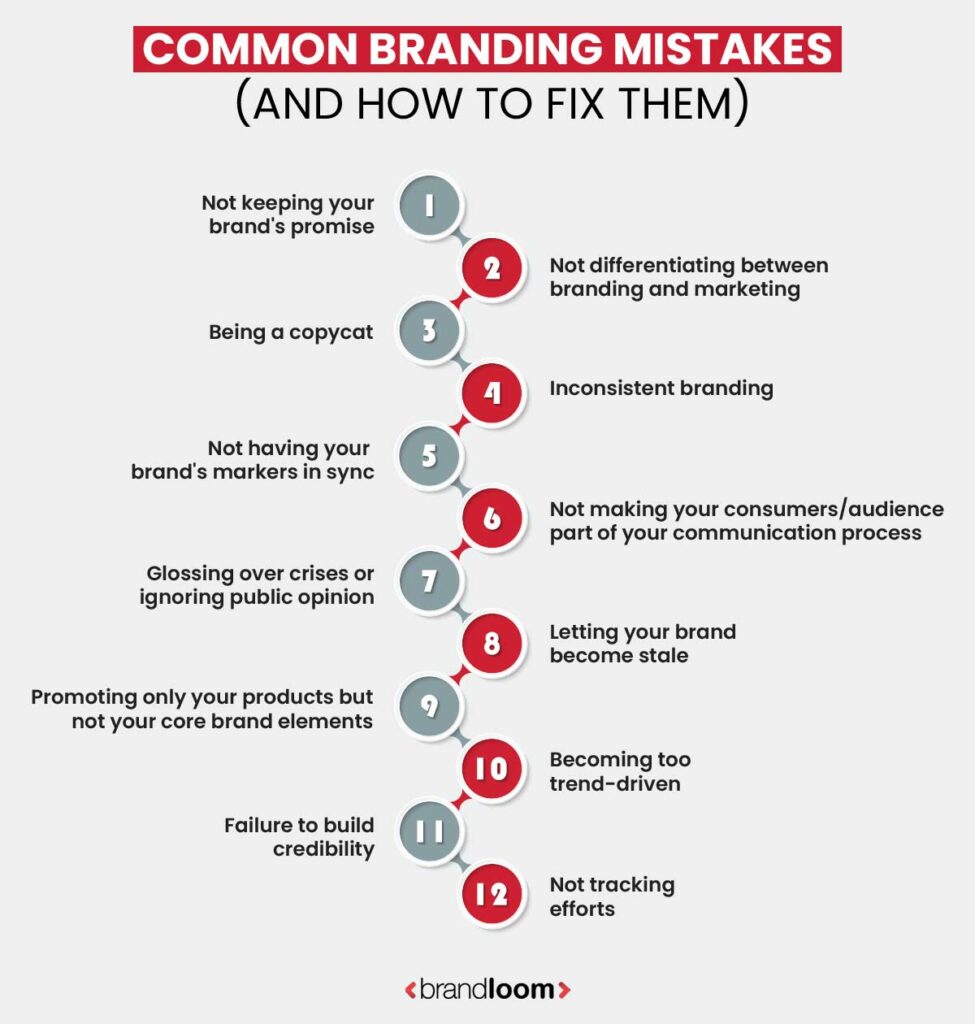
1. Not keeping your brand’s promise – A Common Branding Mistakes
Every brand exists to make a positive difference in the world. The most damaging thing a brand can do is to promise something and then not keep that. Once out, the offending brands may find it difficult to regain their audience’s trust or their market goodwill.
Take the case of Nestle, which promised in 2018 that it would make all its packaging recyclable or reusable by 2025. While it all sounded good on paper, environmental organizations & activists immediately pointed out that Nestle has not made any clear commitments or mentioned any targets or timelines.
Instead, by 2020, it was revealed that Nestle & Coca-Cola are the world’s biggest plastic polluters. The company denied these allegations but still hasn’t provided specific facts or figures about its mission.
Today, the company is still undergoing a “greenwashing” probe in the UK, and its market reputation as an honorable corporate citizen has taken a serious hit.
How to fix it
Do not make a promise that you cannot keep. People are smart, and if you simply pay lip service to a cause without committing to it, they will quickly call you out. If you find yourself in a similar predicament, be honest, apologize unconditionally, and do better.
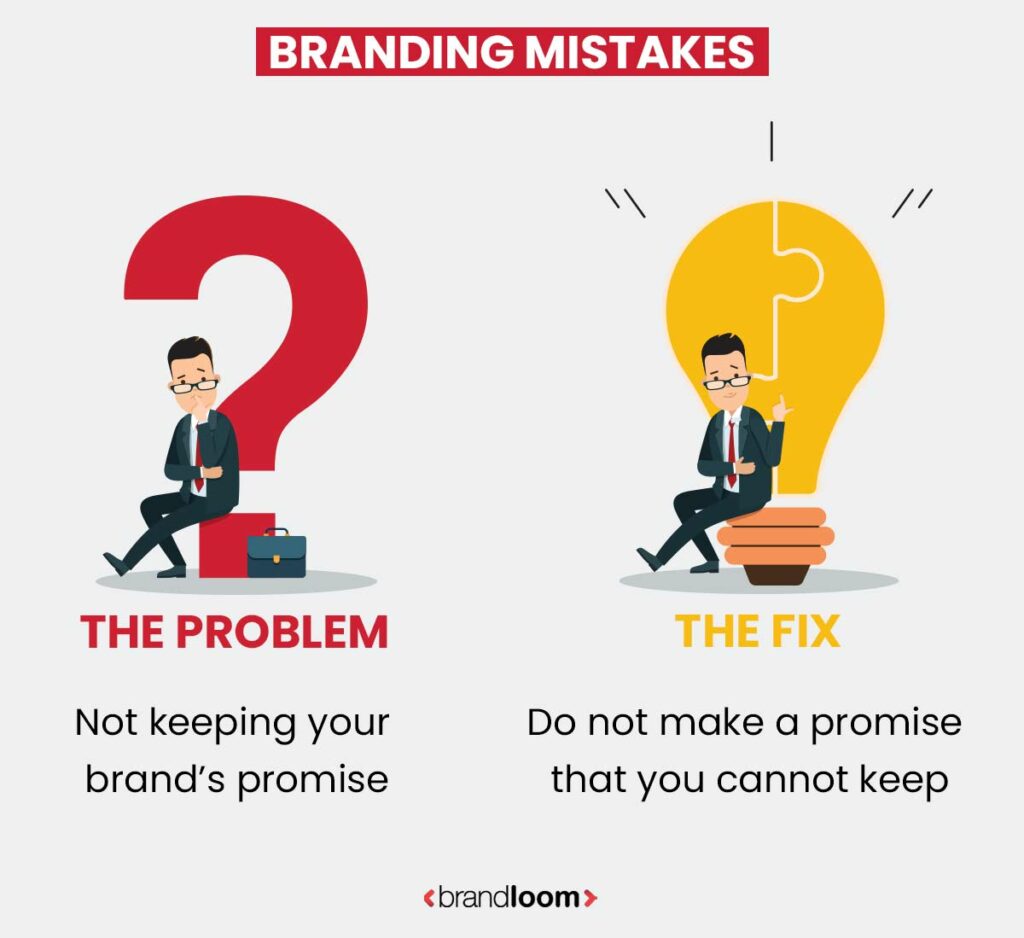
2. Not differentiating between branding and marketing – A Common Branding Mistakes
While these two terms are used interchangeably- they are very different. Branding is about carving out a brand’s distinct identity and philosophy, while marketing is about taking its message out to the world.
The problem starts when brands think both are the same. Many companies simply design an advertising campaign or get a logo and think that they have their brand figured out. This is a short-sighted approach.
Without a steady philosophy, mission, vision, purpose, or brand personality in place, a brand’s communication becomes confusing over time. This makes a brand lose its distinct identity in the market and leads to irrelevance.
How to fix it
Do a branding workshop to have a clear vision of your brand. Figure out your mission, vision, values, personality, tone of voice, central philosophy, and positioning. Then design a long-term branding strategy that will help you carve out a distinct niche in the market. The branding experts at BrandLoom can guide you through the process.
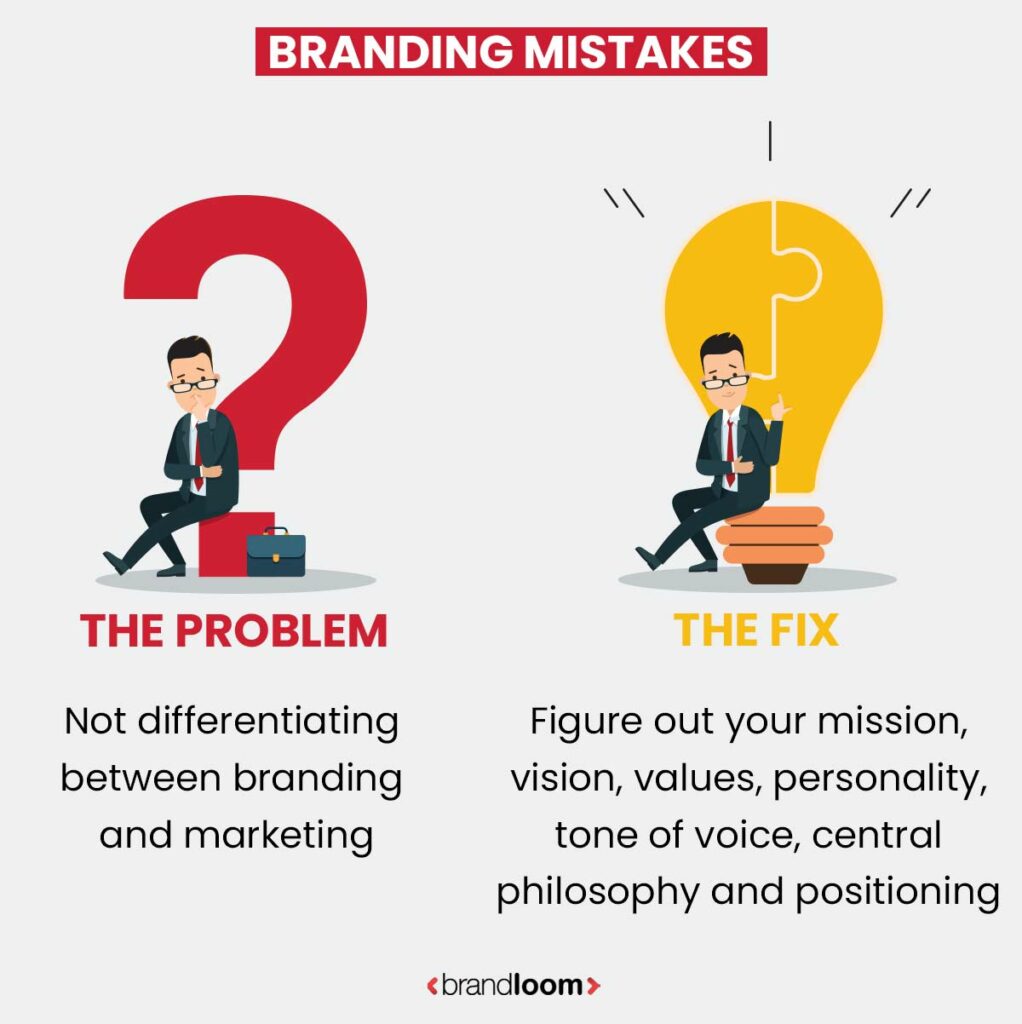
3. Being a copycat – A Common Branding Mistakes
If your brand looks or feels like a clone of something existing, it will lose its relevance. This applies to both branding and marketing campaigns. If your brand’s name invokes the name of another or your logo resembles someone else’s- audiences will simply forget you. The same goes for your ads. If they look or feel like something your audience has already seen before- they will not remember you.
This is because the original species already occupies a distinct space in their minds- and anything that simply feels like a poor imitation of it will be rejected.
But that is not all. Plagiarising an existing brand can land you in legal trouble or even make you the object of widespread ridicule. Nobody wants to associate with someone who steals someone else’s ideas, so that you may lose your reputation forever.
How to fix it
Just don’t do it. Take the time and effort to think of something original and have faith in yourself. If you have made this mistake, accept it, apologize, and NEVER repeat it.
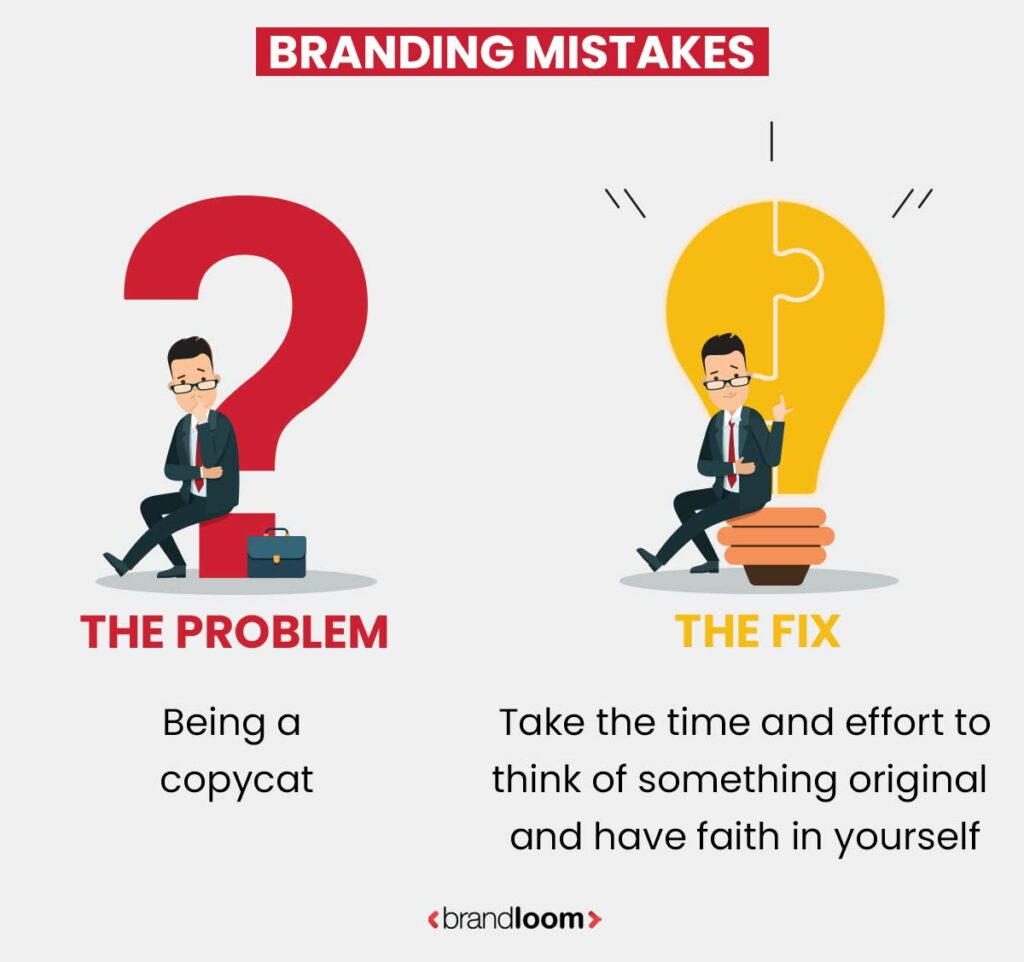
4. Inconsistent branding – A Common Branding Mistakes
Imagine if someone completely changes their appearance and personality every time you see them. They may appear sober and staid, dressed up in neutrals when you meet them today, yet tomorrow they look like bikers and start a fight. Wouldn’t it feel like you are seeing someone completely different?
If a brand frequently changes its appearance, tone of voice, or messaging- it will have the same effect on its audience. Many brands fall prey to this- they have no uniform look, and their messaging varies widely across platforms. This not only confuses the audience, but a lack of any concrete identity also makes them extremely forgettable.
How to fix it
Develop your brand guidelines and stringently implement them. Your brand should feel cohesive. Ensure your content creators, designers, engineers, and marketers know exactly what image you want to create for your brand. When your brand looks and feels consistent, reiterating it over time will make your audiences remember it.
Ignite Your Brand’s Success with BrandLoom – India’s Premier Branding Company! Unleash the power of strategic branding to captivate your audience and dominate the market. Take the first step towards greatness – contact us now!
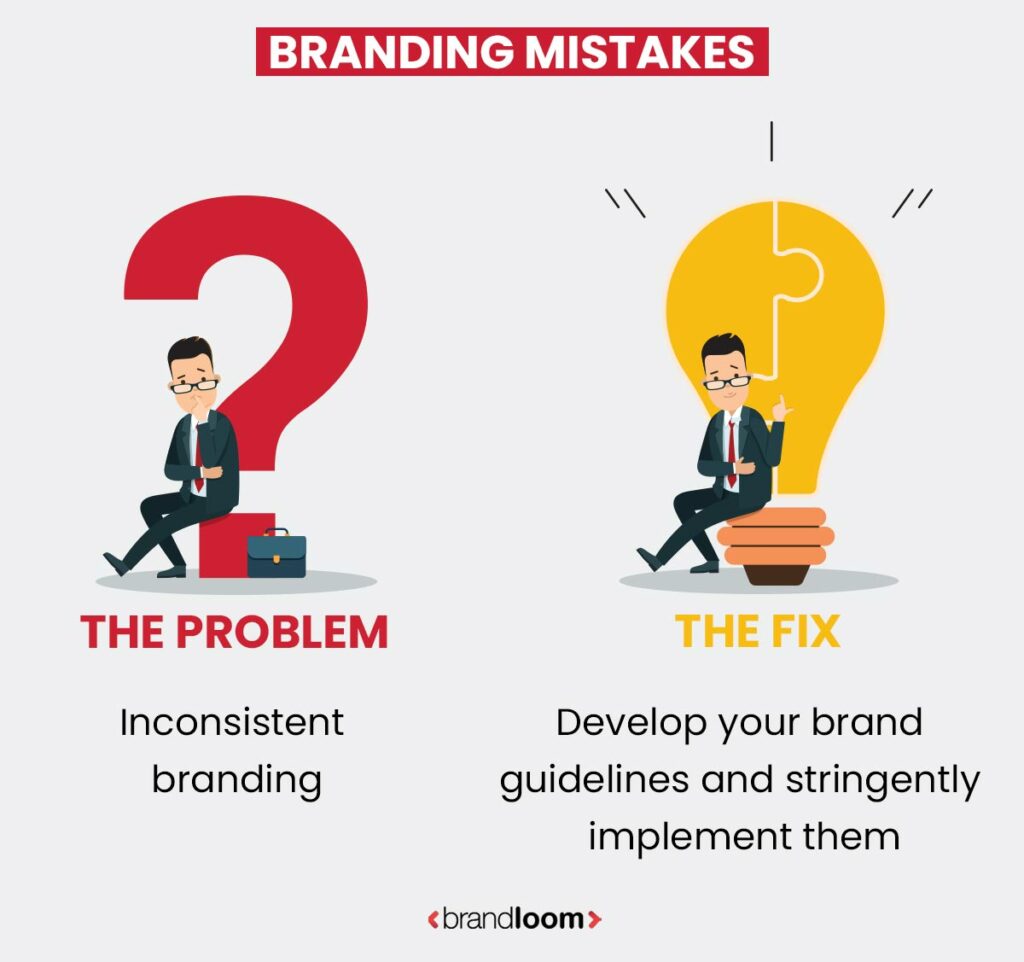
5. Not having your brand’s markers in sync – A Common Branding Mistakes
When four mop-headed gents from Liverpool brought rock and roll to the world, they called themselves The Beatles. Now imagine if they called themselves Black Death while looking like hippies and singing about Strawberry Fields Forever. It would feel incongruous, right?
Your brand’s name, logo, colors, symbols, philosophy, and messaging should all be in sync. Otherwise, you will create a confused image, and your communication will be jumbled.
How to fix it
Note down your brand’s mission, vision, and purpose. Profile your target audience. Now, think of what emotions you want to invoke when people encounter your brand. Choose your brand’s name, logo, colors, and symbols- and then flesh out its personality that feels natural to your created identity.
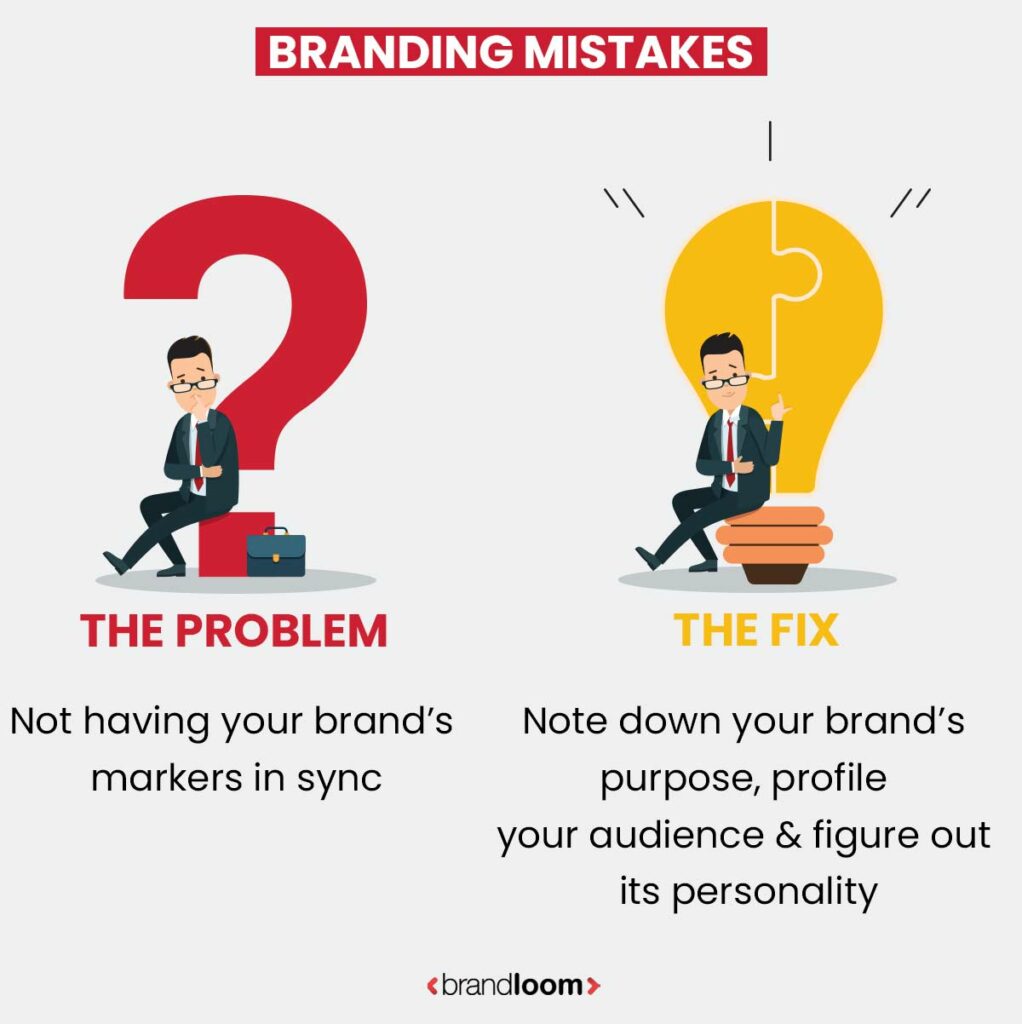
6. Not making your consumers/audience part of your communication process
EVERYTHING in branding and marketing centers around the audience. Perceptions shape a brand- and what YOU want to SAY may completely differ from what your AUDIENCE wants. So if you want to build a brand and grow your business, know exactly who your target audience is and what their expectations are.
The other thing that companies fail to do is not leverage their audiences or consumers to spread the word. Your customers or clients can be your greatest champions- and if you can engage them the right way, your brand can gain much from word-of-mouth publicity.
How to fix it
For the first case, if possible, conduct a market survey. If not, look at audience insights and try to profile your customers. See how your brand impresses them. Try to identify the gaps in the communication process- if your audiences hear something completely different than what you intend to say, you have to tweak your communication strategy & may even have to rebrand.
Ask your audiences to become your brand ambassadors. Engage them with contests, quizzes, giveaways, etc. Reply to their comments promptly. Impress them with extraordinary service- and you can build the next cult brand.
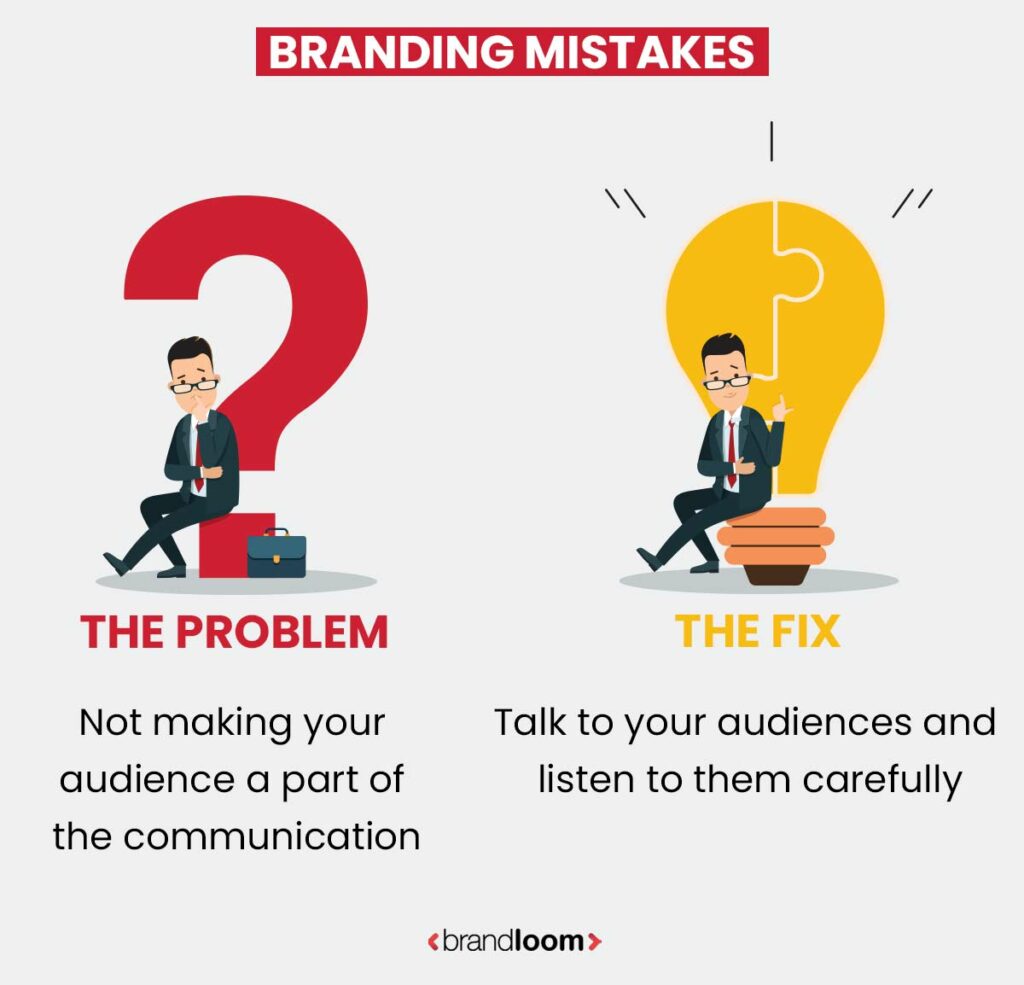
7. Glossing over crises or ignoring public opinion – A Common Branding Mistakes
When BP’s Deepwater Horizon oil rig exploded in 2010, it led to the death of 11 people and the largest oil spill in history. Oil and gas continued to leak for almost 90 days after the incident, contaminating the Gulf of Mexico, killing marine life, and birds, and leaving behind an environmental disaster that continues to impact the world.
Journalists, environmental activists, and scientists pulled up BP for negligence- but the company buried its head in the sand. It refused to take responsibility. The last nail in the coffin was the blithe line their CEO Tony Hayward uttered, “I’d like my life back.”
His casual attitude ignited worldwide outrage, and the company received tremendous backlash from all corners. BP somehow made matters worse with Hayward’s apology, which appeared insincere. And there were still no signs of the company owning up to its mistakes. This ignited a political maelstrom, and the company lost almost a quarter of its market share overnight.
BP’s goodwill never recovered from it. The incident was catastrophic, but what did them in was their seeming indifference to public opinion.
No company- no matter how big- can survive longstanding public ire, especially when they have done something bad on a large scale. Brands that try to gloss over crises can never restore their reputation and must move heaven and earth to retain their credibility.
How to fix it
Just own up to your mistakes and try to make the necessary amends. Yes, bad things may happen- but if your brand tries to shrug it off & does not show proper remorse, it will forever lose people’s trust.
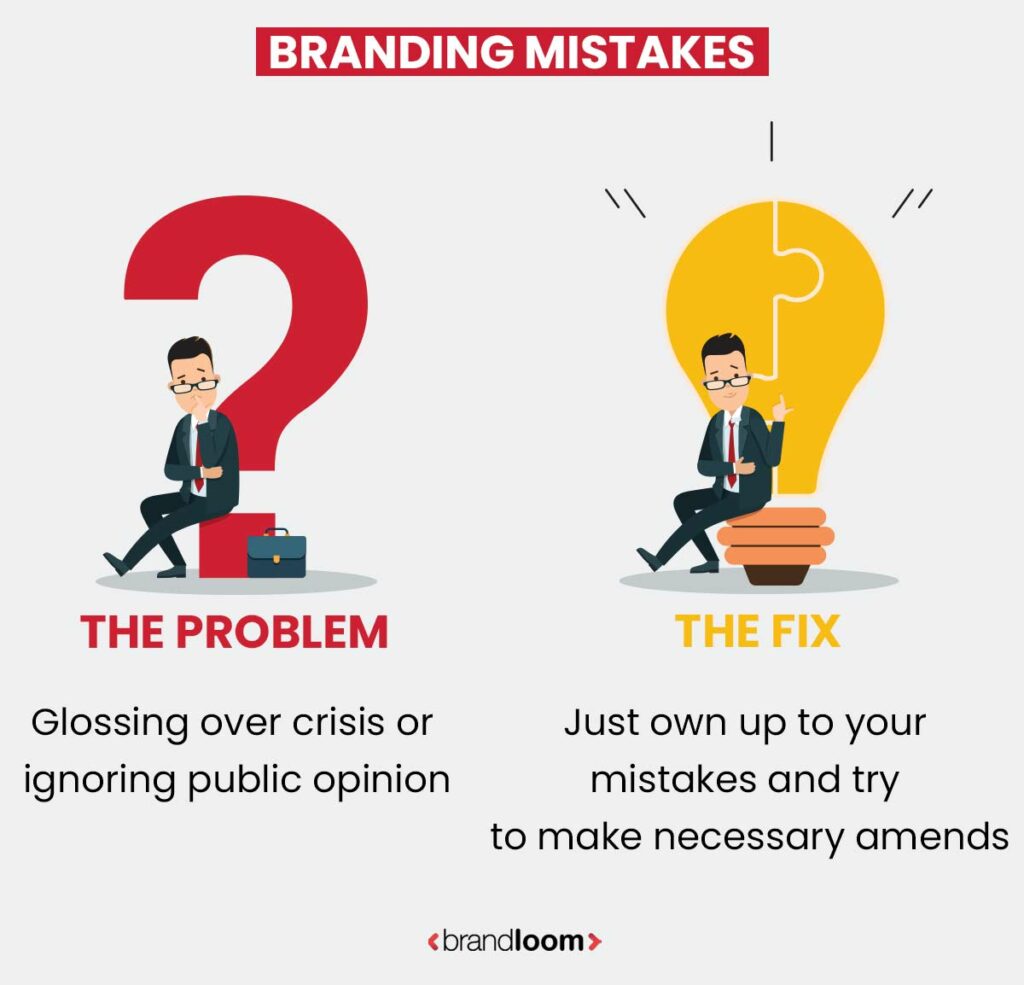
8. Letting your brand become stale – A Common Branding Mistakes
As said before- a brand is a continuous work in progress. As times change, so does a brand’s target audience. The 20-year-old woman to who you’re selling ripped jeans to will graduate to boyfriend jeans within 10 years. The hairstyles of today won’t be in vogue after 5 years. How can a brand stay static in a changing world with new trends?
Some products naturally become irrelevant- like LP records gave way to cassettes. In other instances, brands may no longer appeal to their target audiences. Their initial audiences may evolve, while the brand may still be at a loss to understand what the new generation of customers wants.
When you let your brand get stale- you set it up for failure. A brand not only needs to change with changing times, it also needs to recalibrate its values and messaging. There are truly timeless brands like Nike or Amul- but while they may not rebrand themselves, they keep tweaking their communication subtly to stay relevant to the changing world.
How to fix it
Stay alert and sensitive to the world. Every brand should keep an eye on the changes in its industry and constantly stay in touch with its target audience’s expectations. Accordingly, it should keep updating its look, feel, markers, and messaging.
Take the instance of Renault, which changed its logo and simplified it a few years ago. The updated logo was meant to represent a more digitally-enabled brand. The old logo was not rendering uniformly across all surfaces and media- hence, the brand decided to make it sleeker & more suitable for digital formats.
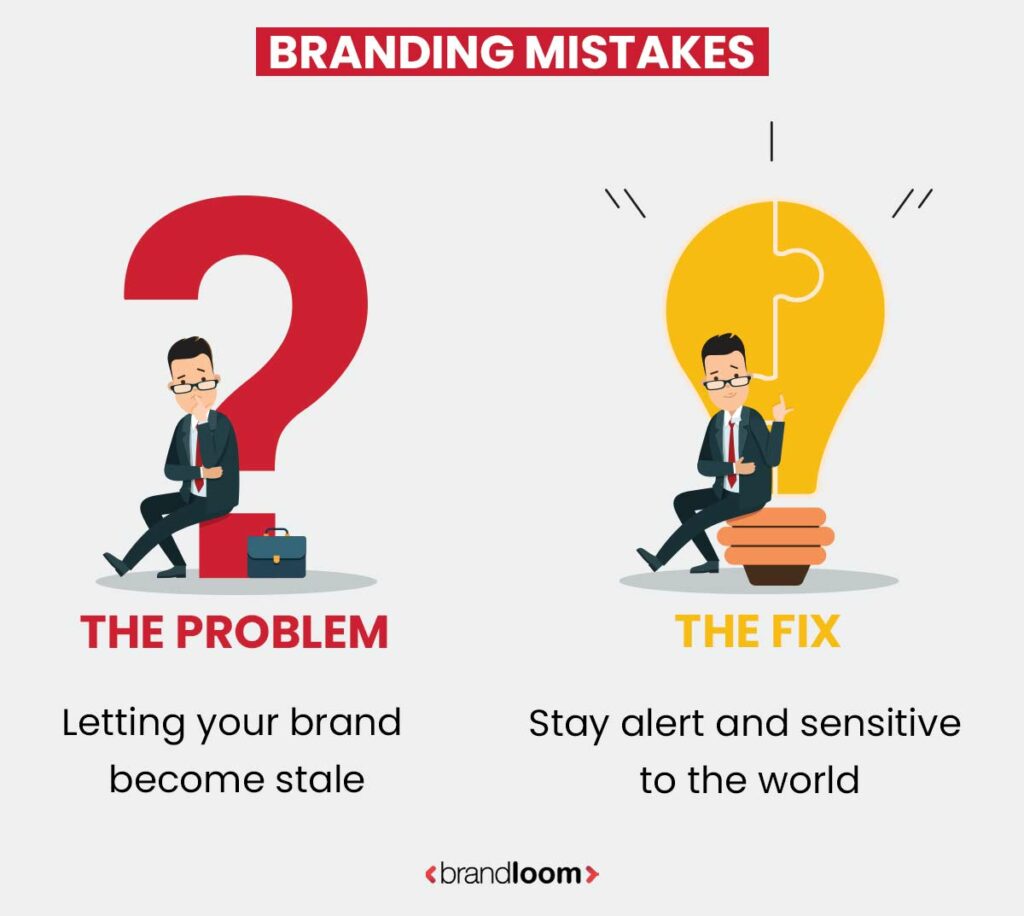
9. Promoting only your products but not your core brand elements
A company is more than its products. And it should make an effort to tell the audience so. For example, we all know the utterly butterly delicious Amul butter- but we all know the brand is so much more than just the product. The Amul Butter girl is also the nation’s voice – she says out aloud what India thinks on every major news development.
Limiting your brand to its product will contract it. You may find it difficult to diversify later, and if your product goes out of fashion, it will kill your brand.
How to fix it
Iterate what your brand is beyond the product it hawks. Talk about your values and vision. Tell people about relevant corporate actions. Tell your story and proclaim your stand on things that matter. Studies show that more shoppers stay loyal to companies whose values and practices they find relatable- so don’t simply promote your products.
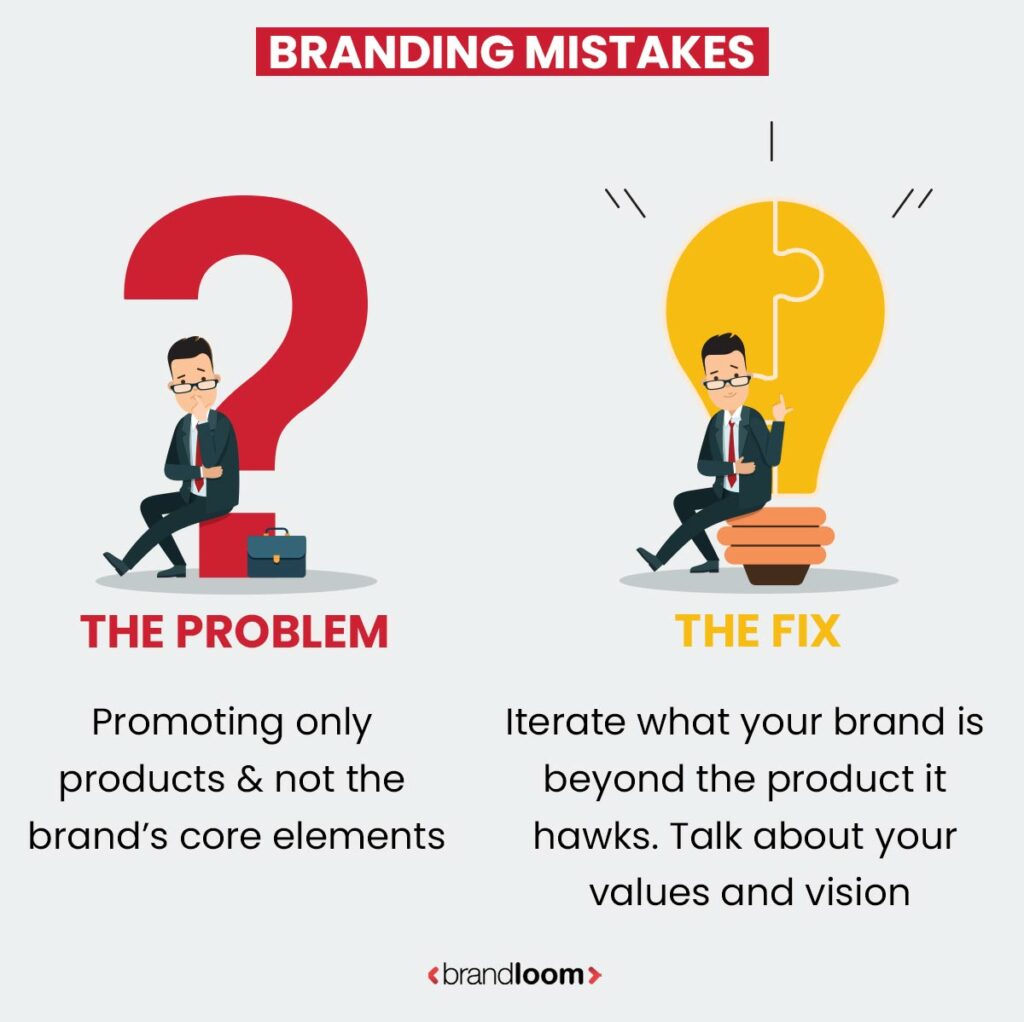
10. Becoming too trend-driven – A Common Branding Mistakes
Trends come and go. If a company becomes too dependent on trends- it will definitely fail. Think of various songs that were based on memes and vines (like Whip/Nae Nae). They fell off the radar just as soon as they appeared. If a company’s entire identity is based on a trend- no matter how big- it will eventually collapse. This bad branding mistake has become too common in the age of social media.
How to fix it
Understand your brand’s purpose and build a timeless identity around it. You can embrace trends for marketing particular products during a certain epoch in time- but don’t get too invested in one particular thing.
Unleash Your Brand’s Potential with BrandLoom – India’s Leading Branding Firm! Ignite a powerful brand presence, captivate your audience, and dominate your industry. Take the leap towards brand excellence – get in touch with us today!
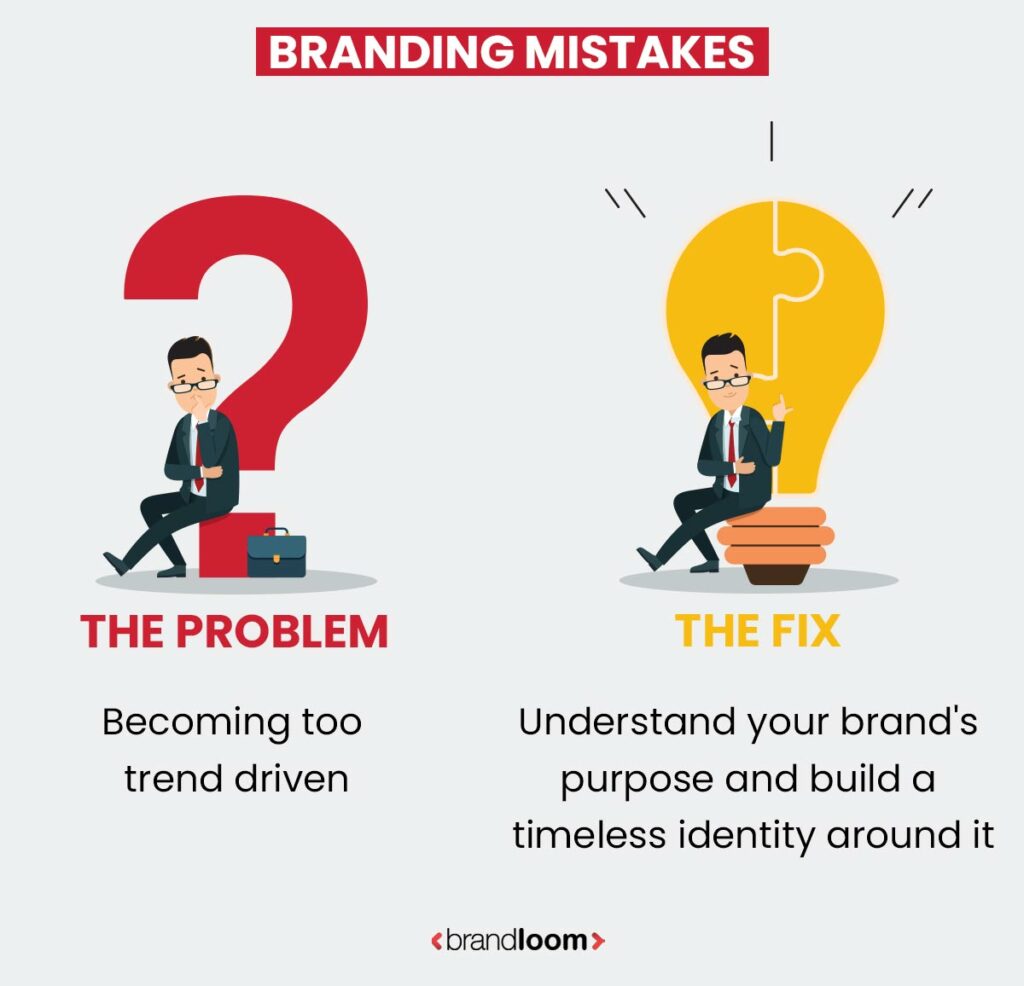
11. Failure to build credibility – A Common Branding Mistakes
When brands cannot back up their claims or show how they have created a positive difference- their credibility fails. This affects not only their reputation but their business as well. All of us are aware of shady companies that make tall claims- like LulaRoe. The infamous leggings MLM company had a spectacular fall from grace when multiple women claimed to be duped by it.
While LulaRoe denies that it victimized anyone, it has lost its credibility. The victims’ testimonies led to journalistic investigations and a Congressional hearing exposing the company’s wrongdoings. It’s impossible now for the company to recover the money or goodwill it lost.
How to fix it
Highlight your best practices- and build credibility by making your customers and employees your brand ambassadors. People trust other people more than empty statements put out by nameless corporations- so show them stories and testimonies that they can trust.
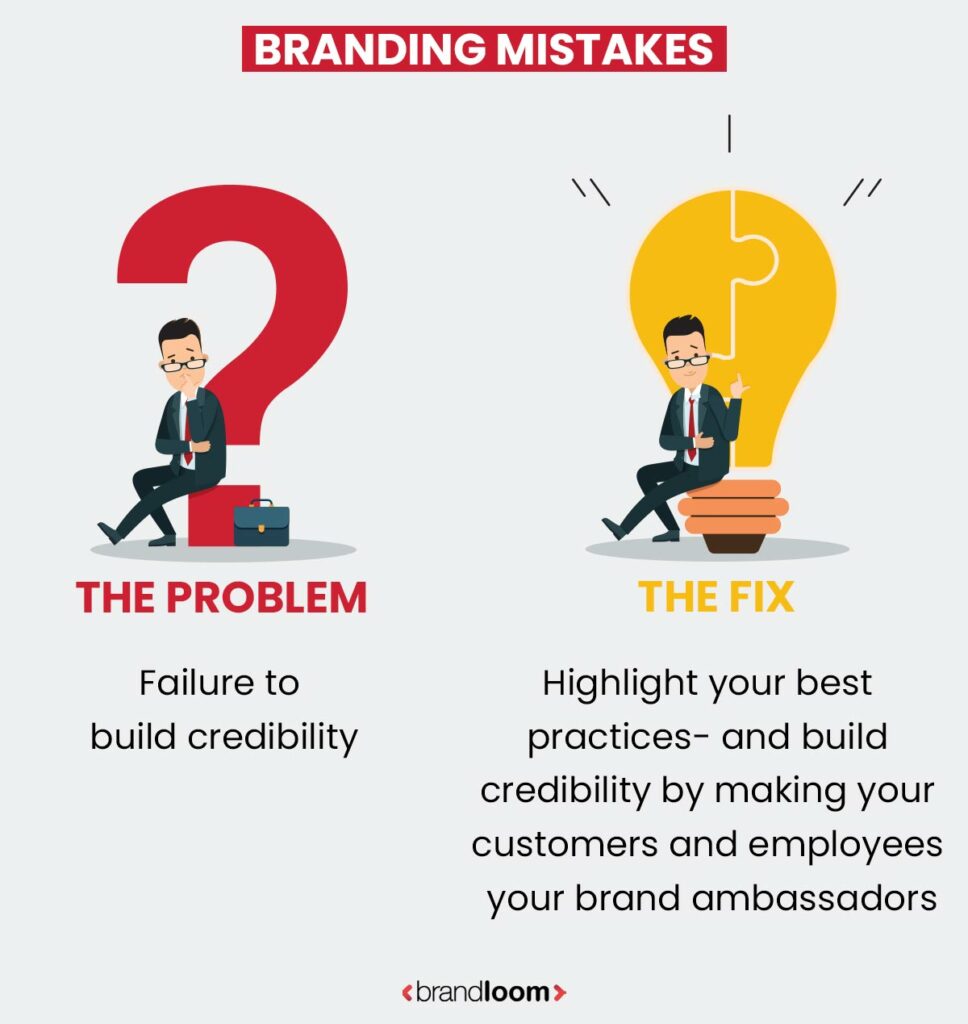
12. Not tracking efforts – A Common Branding Mistakes
Last but not least- if you don’t track how your brand is faring, you will never be able to avoid any pitfalls. Understand how your brand is perceived and how the audiences react to your brand’s markers, products, or messaging. You’re not doing it right if you don’t like what you see.
How to fix it
Conduct surveys online and offline. If someone calls your office, ask them how they came to know about you. Listen to customer feedback, check reviews, and pay attention to what people say on social networks. Decide on your KPIs and stringently track them. Find out what is working and what’s not, and accordingly, rethink your approach.
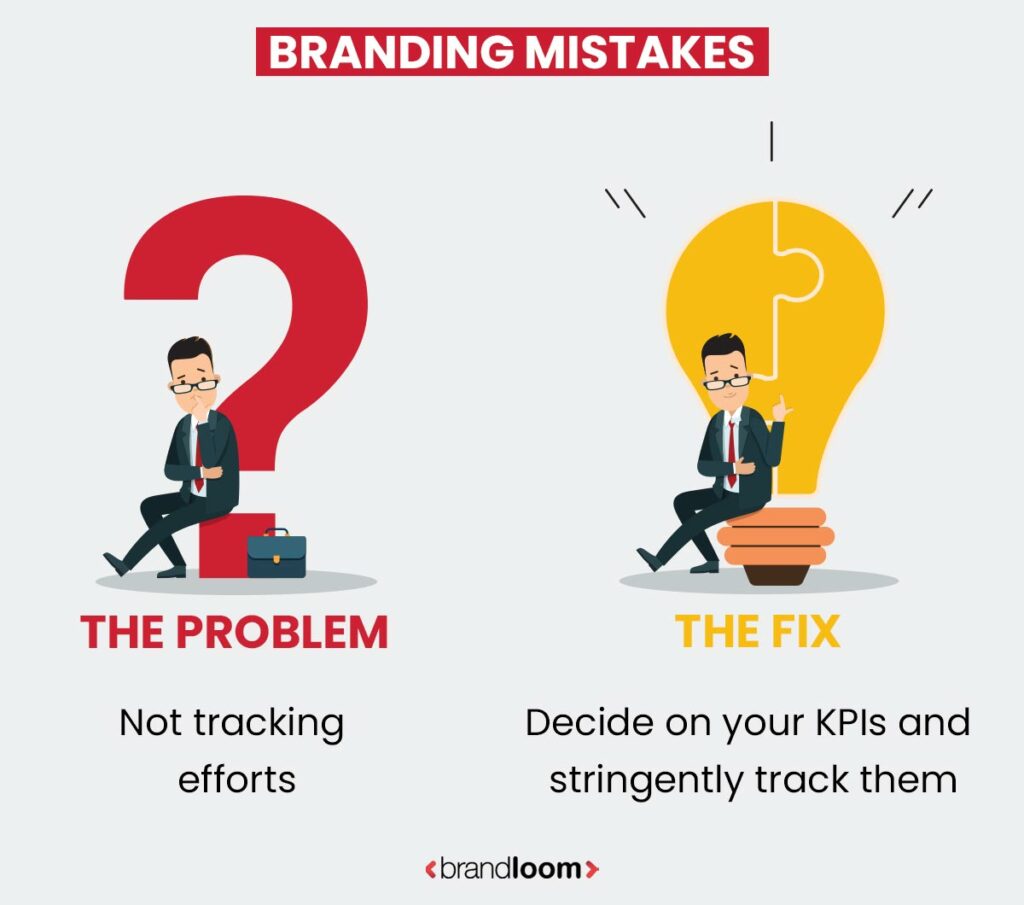
Examples of branding mistakes
Now, let us look at some of the biggest blunders that well-known brands have committed- that serve as a lesson to posterity.
1. Gap’s disastrous rebranding
In 2010, Gap launched a full-scale rebranding and introduced a new logo. The company crowdsourced the new logo and changed the old one overnight.
The result was a universal backlash. The customers were blindsided by the change, which came without warning, and actual designers had a lot of thoughts to offer on the new logo and how the company got it.
The issue snowballed into an absolute nightmare, and just 6 days after getting the new logo, Gap had to return to its old one. Experts estimate Gap’s branding mistake cost $100 mn for a logo that anyone could have designed on MS Paint. It’s one of the most famous branding mistakes in history.
Moral of the story
Don’t crowdsource your rebranding exercise. Get actual branding experts and designers to do it. They would know how to bring about the transition without drastically changing your brand identity markers like your logo or alienating the audience.
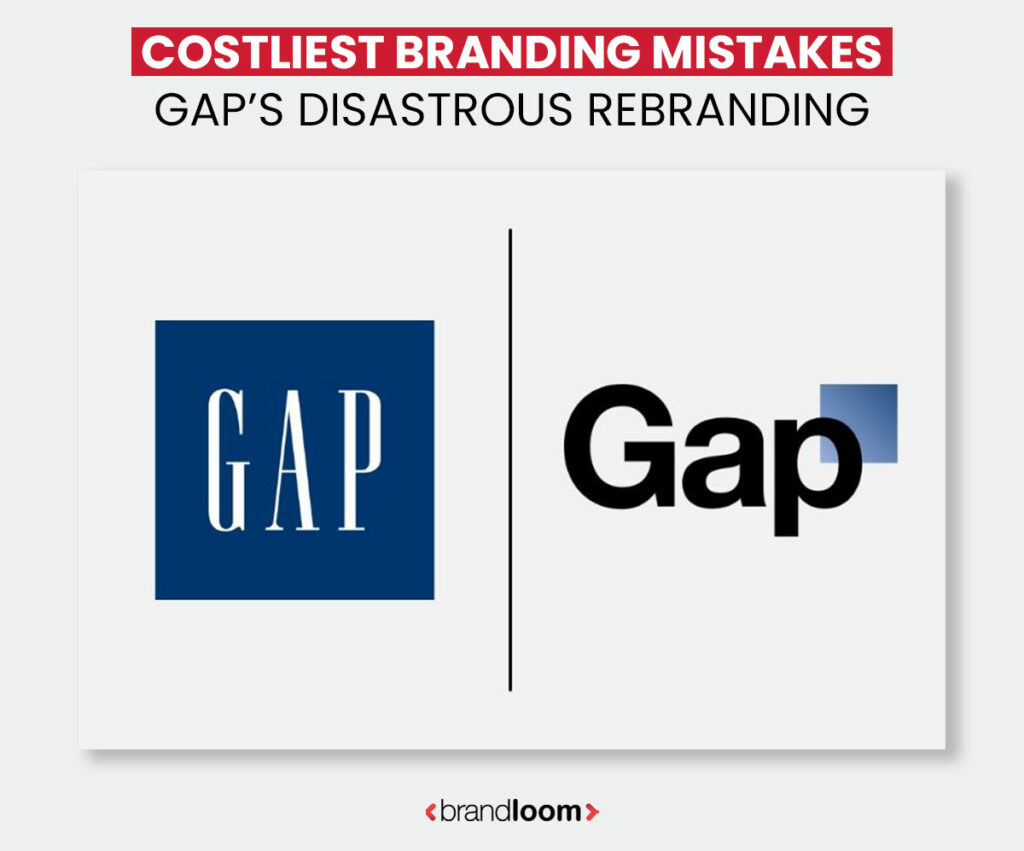
2. Pepsi’s logo redesign
In 2008, Pepsi decided to change its logo. They chose a new one that rotated the original circular icon & turned the white stripe into a smile. What followed was a big international branding mistake.
To say the new logo looked awkward is an understatement. Worse, the “smile” varied in width depending on the surface and product it was rendered on. On top of that, the new logo looked alarmingly similar to the Obama campaign logo.
The new logo cost Pepsi over $1 mn, only to confuse the brand’s audiences. Pepsi had to revert back to its old logo- which meant scrubbing every bottle, packet, truck, and other collateral clean of the new logo.
Moral of the story
Test your logo before implementing it, and ensure it does not remind people of other brands. If your sample audience feels confused, the wider audience will likely have similar issues.
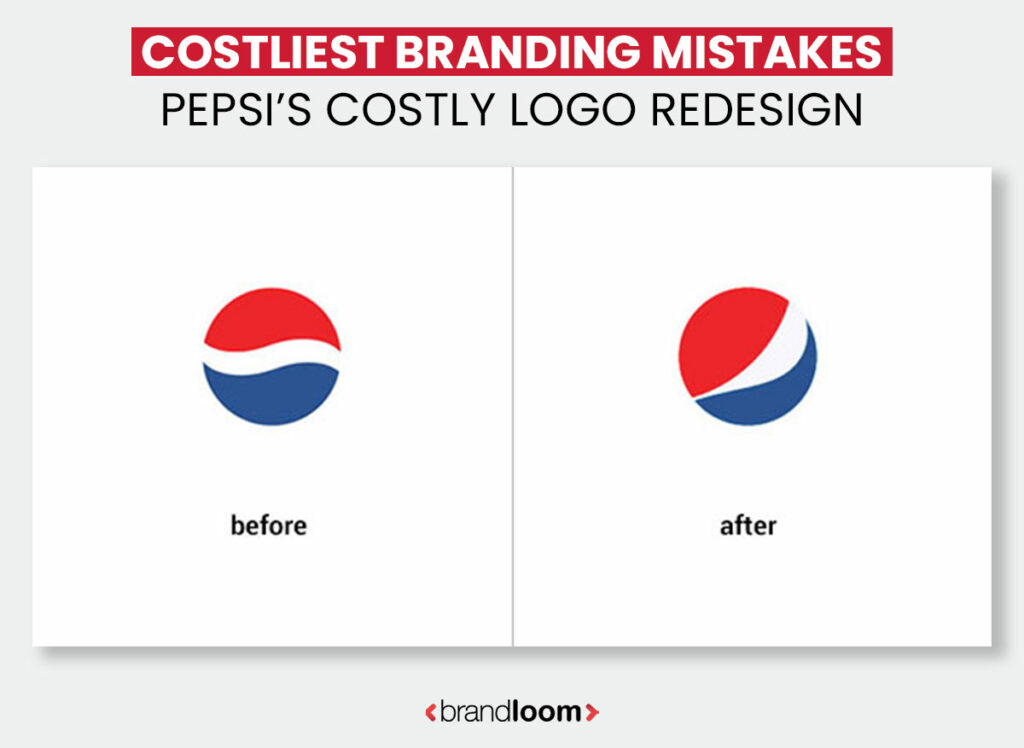
3. Harley Davidson’s cake decoration kit
In a move that befuddled the world, the uber-macho Harley Davidson teamed up with Bakery Crafts and launched a cake decoration kit. Nobody understood who the product was meant for because the intersection between die-hard bikers and baking enthusiasts was pretty slim.
Harley Davidson’s brand extension project became a laughingstock as soon as it launched. It then topped many polls to be named “Worst Brand Extension” of the century. The line was discontinued without much ado, but it had ensured its place in the list of the biggest branding mistakes ever.
Moral of the story
Don’t go for illogical brand extensions, and don’t create something for which there is no target audience.
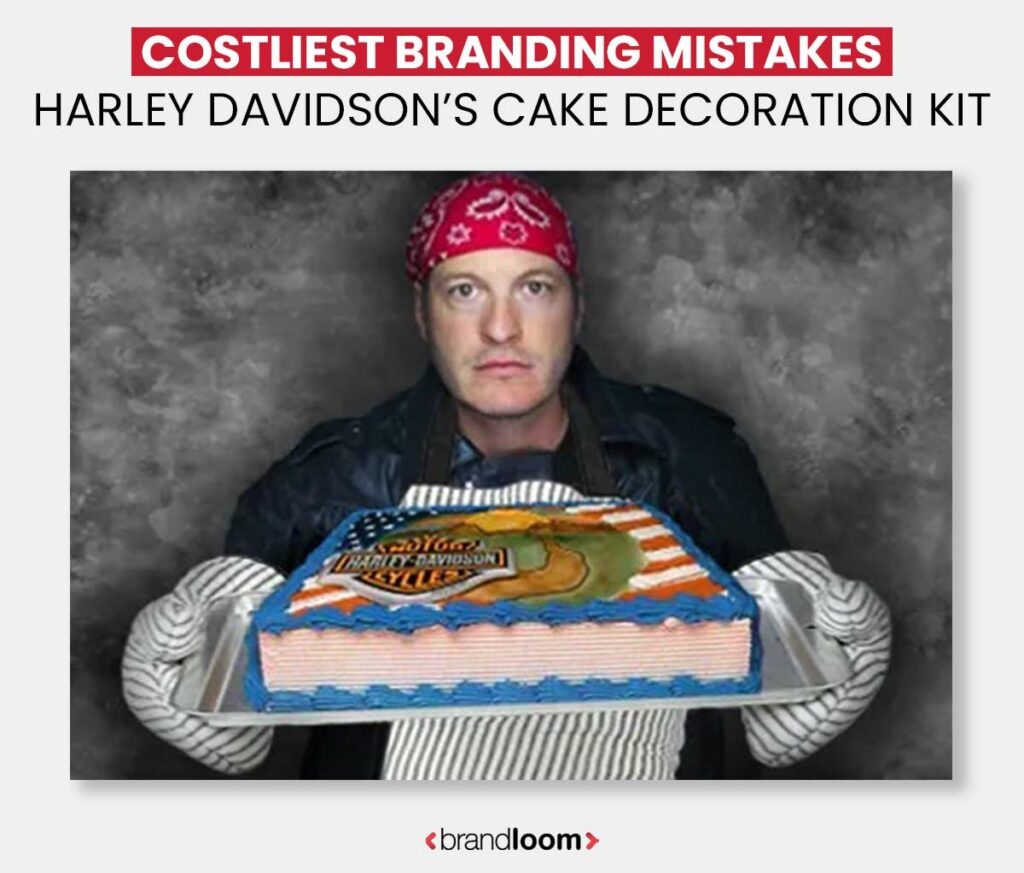
4. Blockbuster refusing to evolve
Blockbuster was movie lovers’ go-to for renting movies to watch at home for decades. At its peak- Blockbuster had 9000 stores across the globe and over 45 million customers.
Then in 1997, it angered a customer named Reed Hastings by charging him late fees. Almost in an act of spite, Hastings launched a little company called Netflix that provided video rentals via emails without late fees. Within a short time, Netflix had become Blockbuster’s main rival.
While the company faced many other problems- it refused to acknowledge the threat that Netflix posed. By 2005, Blockbuster failed to acquire Netflix for $50 million. After the brutal rejection by Blockbuster, Netflix continued to flourish and launched its streaming service in 2007- changing the entertainment landscape forever.
As the world got more internet-friendly, Blockbuster started its downward spiral. It eventually declared bankruptcy.
A lot of Blockbuster’s shortsightedness can be blamed on its unwillingness to look at the changing times. The company kept looking inward, launched & broke partnerships, and made & sandboxed its own movies- all the while NOT looking at how new technologies were changing the world.
As a result, it lost sight of its audience’s changing preferences & expectations; and took a myopic view of emerging threats. Today, the once mighty chain has just ONE standing store in Bend, Oregon. The Blockbuster failure is definitely among the worst branding mistakes of all time.
Moral of the Story
Keep checking the pulse of the market. Your brand may be losing its relevance- if you cannot heed the warning signs, you will soon be obsolete.
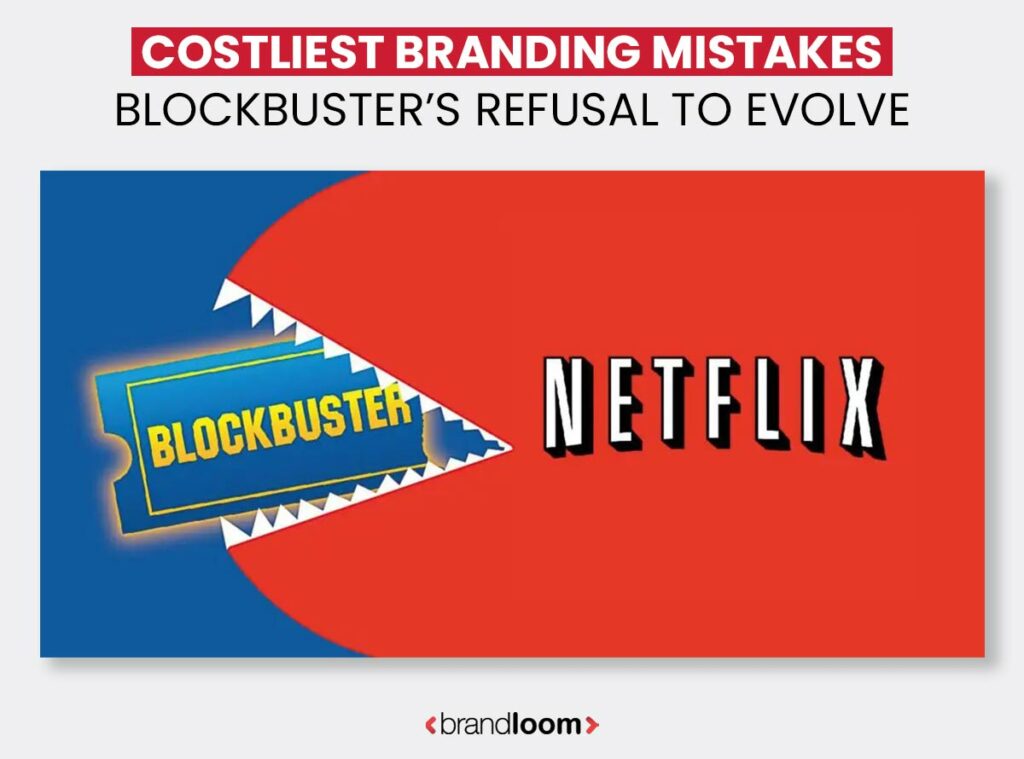
5. Kanye West’s deaf ears- one of the costliest personal branding mistakes
In recent times, no personal brand has failed as spectacularly as Kanye West. After building up his credibility as a massively popular hip-hop artist who had important stories to tell about black hood in the USA, Kanye’s downward spiral began sometime in the mid-2010s.
Kanye had partnered with Adidas to create the massively successful Yeezy sneaker line. However, as his behavior got more erratic, Kanye’s brand suffered. Then around the 2016s, Kanye started mouthing far-right adages, and his downfall started.
Then in 2022- something snapped. Kanye released a show with Balenciaga featuring “white lives matter” tees and then started anti-Semitic rants publicly. While the other brands started scrambling to distance themselves from him- Adidas kept dragging its feet despite the universal backlash.
But towards the end of 2022, Kanye publicly declared he loved Hitler and claimed the dictator was “misunderstood.” He followed that up by tweeting a symbol that combined the Star of David with a Nazi Swastika.
Finally, Adidas broke the partnership. Kanye cemented his position as a cultural pariah and is now a regular fixture on gossip sites as an object of derision and ridicule.
Moral of the Story
A negative brand cannot sustain itself- if you are a contrarian just for the sake of it, your brand will die. If your brand’s purpose is simply to stir drama without having a meaningful vision that changes the world for the better- it will go down on the wrong side of history.
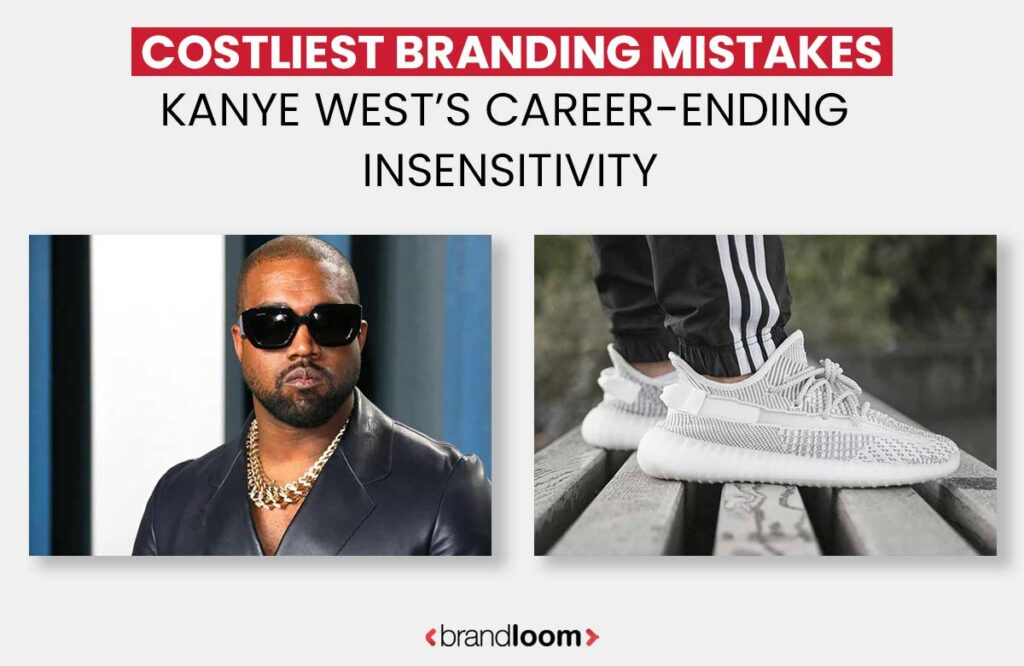
Conclusion
A brand must keep evolving to stay relevant and appeal to its audiences. You need a solid brand strategy to implement your vision and keep tweaking it to ensure you are on the right track. After all, times are always changing, and we need to change with it.
In the process of evolution, you may stumble at times- and sometimes, these can prove to be very costly. So, keep your eyes and ears open for the red flags we discussed. If you have committed a branding mistake- you can talk to the experts at BrandLoom to understand what’s the way forward for your brand.
Frequently Asked Questions on Common Branding Mistakes
What are some common branding mistakes?
Some most common branding mistakes are:
– Not keeping your brand’s promise
– Not differentiating between branding and marketing
– Being a copycat
– Inconsistent branding
– Not having your brand’s markers in sync
– Not making your consumers/audience part of your communication process
– Glossing over crises or ignoring public opinion
– Letting your brand become stale
– Promoting only your products but not your core brand elements
– Becoming too trend-driven
– Failure to build credibility
– Not tracking efforts
To avoid these pitfalls, you must have a good brand strategy and stay alert for possible red flags. If you have made a branding mistake, talk to the experts at BrandLoom for guidance.What is a branding mistake?
A branding mistake is a mistake that a brand makes that can cost them their goodwill in the market and revenues. A branding mistake is defined by its magnitude- a small typo in a social media post will not qualify as a branding mistake, but a major PR disaster will.
Branding mistakes are costly but entirely too common. Even billion-dollar corporations have committed epic faux pas- and some have even gone out of business due to them.What makes branding unscuccessful?
Branding may be unsuccessful for several reasons:
– Your brand is an imitation: If it invokes another- it fails. People remember the one that came first and automatically reject the imitator. Moreover, brands resembling others may even land in legal trouble.
– You don’t know your target audience: If you don’t know who you are speaking to, you won’t be able to communicate well. Brands that don’t know their audiences inevitably fail.
– You don’t know what your brand stands for: What is your brand’s purpose? Its mission? Its vision? Its values? Who is it serving? What are the causes it supports? If you don’t know what lies at your brand’s core- you will never be able to create a good brand strategy. You will lack direction, and your messaging will be muddled.
– Your brand markers are not in sync: If your brand’s essential elements like name, logo, or tagline appear incongruous, it only confuses the audience.
– Your brand has lost relevance: It will eventually collapse if it cannot evolve with time.
You are making poor brand decisions: Illogical expansions, unsustainable brand strategies, or inconsistent brand communication will kill your brand or cost you dearly.
If you want to create a sustainable, good brand- talk to the branding experts at BrandLoom. They can guide you through the process and help you build a brand that is distinct, profitable, and memorable.What is poor branding?
Poor branding happens when a brand cannot shape a clear identity and confuses its audiences. Many things may lead to this:
– Misalignment between the brand markers like the name, logo, and tagline
– Inconsistent branding or widely variable messaging across media or platforms
– Not paying attention to the target audiences or not knowing them
– Failure to find a distinct positioning in the market
– Flawed implementation of its communication strategy
– Confused messaging that does not clarify what the brand stands for.
If you want to ensure your brand does not take these missteps- talk to branding agencies like BrandLoom that can help you create a strong and sustainable brand.What is a bad brand image?
A brand creates a bad impression when its reputation goes for a toss, or its communication is garbled. This may result from a bad name, logo, or tagline, flawed business practices, poor treatment of employees, faulty products, or bad PR practices.
There are many ways in which brands fumble. The solution to it lies in being an ethical business and having a solid brand strategy. A brand strategy focusing on sustainable, long-term growth and meeting your short-term business objectives can help you avoid committing faux pas, or make it easier for you to recover. For the right brand strategy for your brand, talk to the experts at BrandLoom.What are the mistakes of branding?
Branding is all about building a perception of your brand. So, any flaw that compromises your brand’s image will be a mistake in branding. The most common brand mistakes are:
– Brand markers like name, logo, tagline, or packaging not being in sync
– Choppy messaging across different media platforms makes the brand look inconsistent
– Not knowing who your target audience is or what they expect
– Having no distinct positioning that differentiates your brand from the competitors
– Bad communication strategy
– Not having any clear central message
You cannot build a successful and memorable brand if you don’t have clarity on what your brand stands for. If you want to build a good brand, you should get help from the best branding experts from BrandLoom.What happens if you get branding wrong?
If you get your branding wrong or commit a mistake, here is what can happen.
– You can lose your credibility in the market. A brand without a clear purpose or embodying a clear identity will seem unreliable. Imagine if your brand uses different types of logos or its name’s spelling varies. It will make your brand seem unprofessional.
– Your messaging becomes confusing. A brand whose markers like its logo, name, tagline or colors are not in sync will only confuse the audience about its personality or what it stands for.
– You can lose your appeal with your audience. If you don’t know who your audience is or what they expect from you, you won’t be able to communicate with them. Scattered communication will only alienate them.
– You may suffer from revenue loss. Incompetent branding will damage your relationship with your target audiences and result in losses.What is the biggest mistake brands make on social media?
Some big brand mistakes on social media are:
– Inconsistent posting
– No consistent brand guidelines or style
– Posting overtly promotional content
– Posting content that audiences cannot relate to
– Creating content that looks like it’s copy-paste from competitors
– Creating content that is bland and devoid of personality
– Posting content that does not add value to the life of the readers
– Choosing the wrong social media platform to post on
– Becoming too trend-focused
– Trying to use social media as a channel for sales rather than engaging the audience.
Is your brand making any of the mistakes we stated above?What can damage a brand’s image?
Many things can damage a brand. Here are some of the most common ones:
– Not keeping your brand’s promise: This creates a lack of trust among your audiences.
Not differentiating between branding and marketing: Focusing only short-term marketing goals rather than building up the core of a timeless brand.
– Being a copycat: Nobody remembers a photocopy.
– Inconsistent branding: If your brand comes across as erratic, it only confuses audiences and puts them off.
– Not having your brand’s markers in sync: This, again, creates confusion about your brand’s personality and who it targets.
– Not making your consumers/audience part of your communication process: You cannot build a credible communication strategy without looking at or understanding your audiences.
– Glossing over crises or ignoring public opinion: Coming across as brazen or unempathetic is a PR disaster most brands cannot live down.
– Letting your brand become stale: If it looks and feels dated, it will no longer be able to stay relevant to the changing times.
– Promoting only your products but not your core brand elements: Overtly promotional messaging puts off your audiences and makes you seem like just another salesman. Try impressing them with your unique personality.
– Becoming too trend-driven: Trends come and go. You are mistaken if you think you can just jump onto a bandwagon, which will be enough to sustain your brand through the ages.
– Failure to build credibility: If you cannot build trust with the audience- say goodbye to any chances of your brand’s survival.
– Not tracking efforts: If you don’t track whether you are engaging your audiences the right way- you will not know what your strengths or weaknesses are.What is weakness of a brand?
A brand’s weakness can be defined as some inherent flaw that makes it difficult for it to reach its full potential or sustain itself. If you don’t understand your brand’s weakness, your brand strategy will also be weak.
A good brand strategy starts by acknowledging and understanding the brand’s weakness, and then looks at addressing it. Ignoring it will be a massive brand mistake that can jeopardize your business.
The weakness of a brand can be a variety of things, including sub-par products, muddled brand messaging, consistently bad PR, a bad reputation as an employer, unethical business practices, forgettable branding, or ill-reputed customer relationships. If your brand has a weakness, acknowledge it honestly, and then do a branding exercise with professionals from BrandLoom who can help you address it.Why do most brands fail in India and abroad? What do brands struggle with?
Brands may fail for a variety of reasons.
– Lack of Differentiation and Relevance: Brands that struggle to stand out from rivals and endure in the marketplace run the danger of failing.
– Poor Financial Management: Financial problems, such as excessive debt, poor cash flow management, or unsustainable business strategies, can ruin brands. Instability and insufficient financial resources can make it difficult for a business to invest in new products, marketing campaigns, and operational upgrades.
– Ineffective Marketing and Branding: A brand may struggle to establish momentum and lose market share if its value is not successfully communicated, the relevant audience is not reached through the proper channels, or its messaging is inconsistent.
– Issues with Quality and Customer Experience: Consistently producing inferior products or services or giving customers a poor experience can hurt a brand’s reputation and make customers unhappy. Negative feedback, complaints, and a lack of trust can reduce sales and customer loyalty, eventually resulting in brand failure.
– Failure to Adjust to Market Changes: A brand may become obsolete if it ignores or fails to react to changes in consumer behavior, new trends, or technical developments. Brands that do not innovate or adapt to market developments risk losing their market share and relevancy.Why do brands lose customers?
Brands may lose customers if they commit some serious branding mistakes. Some instances of that would be:
– Bad PR
– Flawed products
– Lack of innovation
– Lack of differentiation
– Ignoring audiences
– Losing relevance
– Inability to put together a cohesive, consistent identity
A branding mistake can get you in trouble and lose your customers. Besides, studies show that customers identify with and shop more with brands whose values align with them. So, if you don’t want to lose your customers- have the experts at BrandLoom formulate a good brand strategy for you.What is brand crisis?
A brand crisis happens when a brand’s reputation takes a hit or when it is ill-prepared to deal with sudden upheavals. A brand crisis can happen because of:
– Failures of the product or service: Problems with the quality, safety, or performance of a product or service can result in a brand crisis.
– Ethical or unlawful Misconduct: Any unethical or unlawful actions taken by a brand or its affiliated businesses might have dire repercussions.
– Data Breach and Security Concerns: Companies that handle client data and have security issues may endure a serious brand crisis.
– Public Relations Problems: Ineffective crisis management, a lack of openness, or a subpar response to a problem can turn a small problem into a major brand catastrophe.
– Competition and Market Challenges: Brand crises can be brought on by fierce competition, disruptive market factors, or swift changes in customer preferences.What is the #1 rule of branding?
While a brand may commit many branding mistakes- the one thing it should avoid at all costs is coming across as inconsistent. If your brand does not stay consistent across platforms, in all its iterations, through time, or between its key markers, it will put off its audiences sooner or later.
So, the number one rule of branding is- to stay consistent. Create a cohesive, consistent, timeless brand – and keep iterating it. If that feels intimidating, you can talk to the branding experts at BrandLoom.

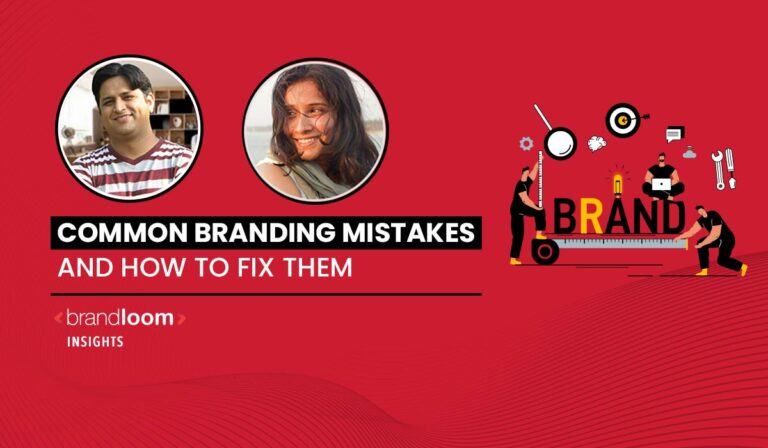




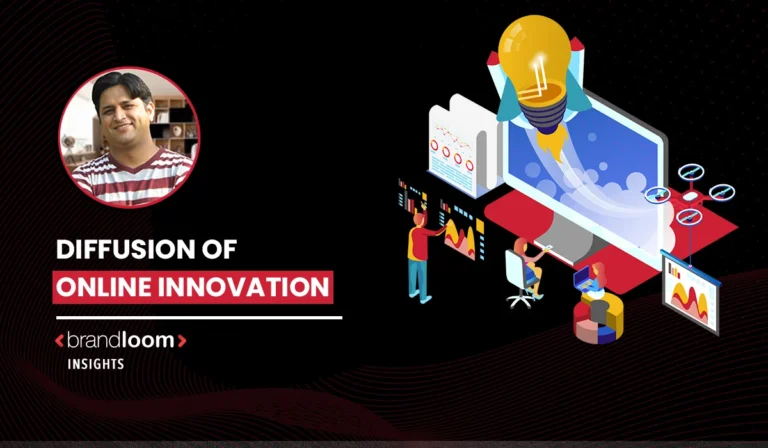
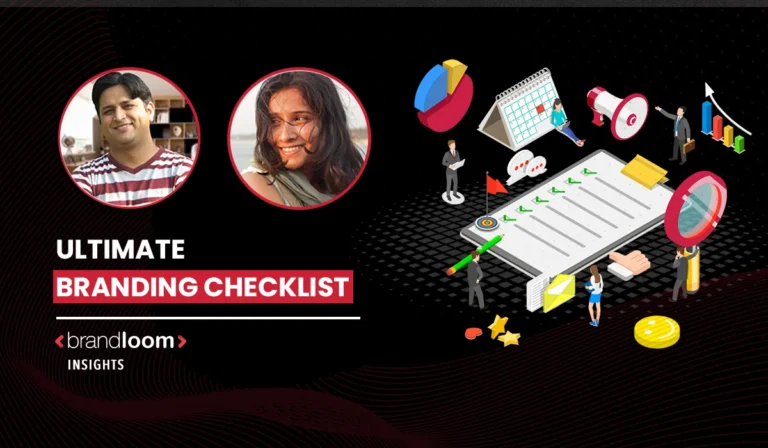
I really enjoyed reading this post! It’s amazing how small branding mistakes can have such a significant impact on business growth. If anyone is looking to dive deeper into this topic, I highly recommend checking out this article on the 5 branding mistakes hurting your business. It offers some valuable insights that can help you refine your branding strategy!